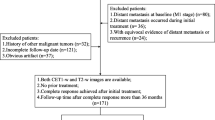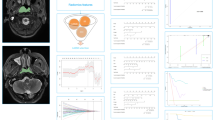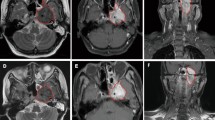Abstract
Objectives
To establish and validate a radiomics nomogram for prediction of induction chemotherapy (IC) response and survival in nasopharyngeal carcinoma (NPC) patients.
Methods
One hundred twenty-three NPC patients (100 in training and 23 in validation cohort) with multi-MR images were enrolled. A radiomics nomogram was established by integrating the clinical data and radiomics signature generated by support vector machine.
Results
The radiomics signature consisting of 19 selected features from the joint T1-weighted (T1-WI), T2-weighted (T2-WI), and contrast-enhanced T1-weighted MRI images (T1-C) showed good prognostic performance in terms of evaluating IC response in two cohorts. The radiomics nomogram established by integrating the radiomics signature with clinical data outperformed clinical nomogram alone (C-index in validation cohort, 0.863 vs 0.549; p < 0.01). Decision curve analysis demonstrated the clinical utility of the radiomics nomogram. Survival analysis showed that IC responders had significant better PFS (progression-free survival) than non-responders (3-year PFS 84.81% vs 39.75%, p < 0.001). Low-risk groups defined by radiomics signature had significant better PFS than high-risk groups (3-year PFS 76.24% vs 48.04%, p < 0.05).
Conclusions
Multiparametric MRI-based radiomics could be helpful for personalized risk stratification and treatment in NPC patients receiving IC.
Key Points
• MRI Radiomics can predict IC response and survival in non-endemic NPC.
• Radiomics signature in combination with clinical data showed excellent predictive performance.
• Radiomics signature could separate patients into two groups with different prognosis.






Similar content being viewed by others
Abbreviations
- CCRT:
-
Concurrent chemoradiation
- IC:
-
Induction chemotherapy
- IMRT:
-
Intensity-modulated radiotherapy
- LASSO:
-
Least absolute shrinkage and selection operator
- NPC:
-
Nasopharyngeal carcinoma
- PFS:
-
Progression-free survival
- RF:
-
Random forest
- SVM:
-
Support vector machine
- T1-C:
-
T1 contrast
References
Zang J, Li C, Zhao LN et al (2016) Prognostic model of death and distant metastasis for nasopharyngeal carcinoma patients receiving 3DCRT/IMRT in nonendemic area of China. Medicine (Baltimore) 95:e3794
Zhao LN, Zhou B, Shi M et al (2012) Clinical outcome for nasopharyngeal carcinoma with predominantly WHO II histology treated with intensity-modulated radiation therapy in non-endemic region of China. Oral Oncol 48:864–869
Al-Sarraf M, LeBlanc M, Giri PG et al (1998) Chemoradiotherapy versus radiotherapy in patients with advanced nasopharyngeal cancer: phase III randomized intergroup study 0099. J Clin Oncol 16:1310–1317
Wang J, Shi M, Hsia Y et al (2012) Failure patterns and survival in patients with nasopharyngeal carcinoma treated with intensity modulated radiation in Northwest China: a pilot study. Radiat Oncol 7:2
Wee CW, Keam B, Heo DS, Sung MW, Won TB, Wu HG (2015) Locoregionally advanced nasopharyngeal carcinoma treated with intensity-modulated radiotherapy plus concurrent weekly cisplatin with or without neoadjuvant chemotherapy. Radiat Oncol J 33:98–108
Blanchard P, Lee A, Marguet S et al (2015) Chemotherapy and radiotherapy in nasopharyngeal carcinoma: an update of the MAC-NPC meta-analysis. Lancet Oncol 16:645–655
Cao SM, Yang Q, Guo L et al (2017) Neoadjuvant chemotherapy followed by concurrent chemoradiotherapy versus concurrent chemoradiotherapy alone in locoregionally advanced nasopharyngeal carcinoma: a phase III multicentre randomised controlled trial. Eur J Cancer 75:14–23
Zhao L, Xu M, Jiang W et al (2017) Induction chemotherapy for the treatment of non-endemic locally advanced nasopharyngeal carcinoma. Oncotarget 8:6763–6774
Peng H, Chen L, Zhang Y et al (2016) The tumour response to induction chemotherapy has prognostic value for long-term survival outcomes after intensity-modulated radiation therapy in nasopharyngeal carcinoma. Sci Rep 6:24835
Zhang GY, Wang YJ, Liu JP et al (2015) Pretreatment diffusion-weighted MRI can predict the response to neoadjuvant chemotherapy in patients with nasopharyngeal carcinoma. Biomed Res Int 2015:307943
Yen RF, Chen TH, Ting LL, Tzen KY, Pan MH, Hong RL (2005) Early restaging whole-body (18)F-FDG PET during induction chemotherapy predicts clinical outcome in patients with locoregionally advanced nasopharyngeal carcinoma. Eur J Nucl Med Mol Imaging 32:1152–1159
Gillies RJ, Kinahan PE, Hricak H (2016) Radiomics: images are more than pictures, they are data. Radiology 278:563–577
Verma V, Simone CB 2nd, Krishnan S, Lin SH, Yang J, Hahn SM (2017) The rise of radiomics and implications for oncologic management. J Natl Cancer Inst 109
Mao J, Fang J, Duan X et al (2019) Predictive value of pretreatment MRI texture analysis in patients with primary nasopharyngeal carcinoma. Eur Radiol. https://doi.org/10.1007/s00330-018-5961-6
Zhang B, Tian J, Dong D et al (2017) Radiomics features of multiparametric MRI as novel prognostic factors in advanced nasopharyngeal carcinoma. Clin Cancer Res. https://doi.org/10.1158/1078-0432.CCR-16-2910
Wang G, He L, Yuan C, Huang Y, Liu Z, Liang C (2018) Pretreatment MR imaging radiomics signatures for response prediction to induction chemotherapy in patients with nasopharyngeal carcinoma. Eur J Radiol 98:100–106
Eisenhauer EA, Therasse P, Bogaerts J et al (2009) New response evaluation criteria in solid tumours: revised RECIST guideline (version 1.1). Eur J Cancer 45:228–247
Sauerbrei W, Royston P, Binder H (2007) Selection of important variables and determination of functional form for continuous predictors in multivariable model building. Stat Med 26:5512–5528
Smyser CD, Dosenbach NU, Smyser TA et al (2016) Prediction of brain maturity in infants using machine-learning algorithms. Neuroimage 136:1–9
Liu Z, Zhang XY, Shi YJ et al (2017) Radiomics analysis for evaluation of pathological complete response to neoadjuvant chemoradiotherapy in locally advanced rectal cancer. Clin Cancer Res 23:7253–7262
Contal COQJ (1999) An application of changepoint methods in studying the effect of age on survival in breast cancer. Comput Stat Data Anal 30:253–270
Cui Z, Xia Z, Su M, Shu H, Gong G (2016) Disrupted white matter connectivity underlying developmental dyslexia: a machine learning approach. Hum Brain Mapp 37:1443–1458
Liao XB, Mao YP, Liu LZ et al (2008) How does magnetic resonance imaging influence staging according to AJCC staging system for nasopharyngeal carcinoma compared with computed tomography? Int J Radiat Oncol Biol Phys 72:1368–1377
Liu J, Mao Y, Li Z et al (2016) Use of texture analysis based on contrast-enhanced MRI to predict treatment response to chemoradiotherapy in nasopharyngeal carcinoma. J Magn Reson Imaging 44:445–455
Zhang B, Ouyang F, Gu D et al (2017) Advanced nasopharyngeal carcinoma: pre-treatment prediction of progression based on multi-parametric MRI radiomics. Oncotarget 8:72457–72465
Panth KM, Leijenaar RT, Carvalho S et al (2015) Is there a causal relationship between genetic changes and radiomics-based image features? An in vivo preclinical experiment with doxycycline inducible GADD34 tumor cells. Radiother Oncol 116:462–466
Diehn M, Nardini C, Wang DS et al (2008) Identification of noninvasive imaging surrogates for brain tumor gene-expression modules. Proc Natl Acad Sci U S A 105:5213–5218
Lee J, Narang S, Martinez J, Rao G, Rao A (2015) Spatial habitat features derived from multiparametric magnetic resonance imaging data are associated with molecular subtype and 12-month survival status in glioblastoma multiforme. PLoS One 10:e0136557
Zhou M, Leung A, Echegaray S et al (2017) Non-small cell lung cancer radiogenomics map identifies relationships between molecular and imaging phenotypes with prognostic implications. Radiology. https://doi.org/10.1148/radiol.2017161845:161845
Mani S, Chen Y, Li X et al (2013) Machine learning for predicting the response of breast cancer to neoadjuvant chemotherapy. J Am Med Inform Assoc 20:688–695
Funding
This study has received funding by the National Natural Science Foundation of China Grants 81872699 and Key project of Shanxi Province 2017ZDXM-SF-043.
Author information
Authors and Affiliations
Corresponding authors
Ethics declarations
Guarantor
The scientific guarantor of this publication is Lina Zhao.
Conflict of interest
The authors of this manuscript declare no relationships with any companies, whose products or services may be related to the subject matter of the article.
Statistics and biometry
Yutian Yin, one of the authors, has significant statistical expertise.
Informed consent
Written informed consent was not required for this study because the retrospective nature of the study.
Ethical approval
Institutional Review Board approval was obtained.
Methodology
• retrospective
• diagnostic or prognostic study
• performed at one institution
Additional information
Publisher’s note
Springer Nature remains neutral with regard to jurisdictional claims in published maps and institutional affiliations.
Electronic supplementary material
ESM 1
(DOCX 1217 kb)
Rights and permissions
About this article
Cite this article
Zhao, L., Gong, J., Xi, Y. et al. MRI-based radiomics nomogram may predict the response to induction chemotherapy and survival in locally advanced nasopharyngeal carcinoma. Eur Radiol 30, 537–546 (2020). https://doi.org/10.1007/s00330-019-06211-x
Received:
Revised:
Accepted:
Published:
Issue Date:
DOI: https://doi.org/10.1007/s00330-019-06211-x




